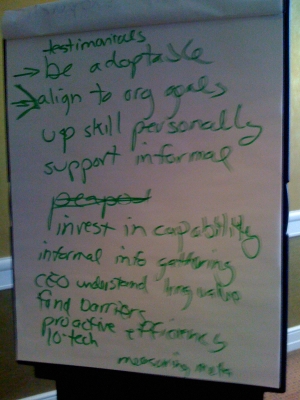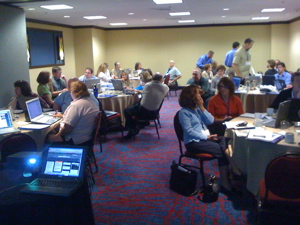For sins in my past, I’ve been invited on to our school district’s technology committee. So, yesterday evening I was there as we were reviewing and rewriting the technology plan (being new to the committee, I wasn’t there when the existing one was drafted). Broken up into five parts, including curriculum, infrastructure, funding, I was on the professional development section, with a teacher and a library media specialist. Bear with me, as the principles here are broader than schools.
The good news: they’d broken up goals into two categories, the teacher’s tech skills, and the integration of tech into the curriculum. And they were measuring the tech skills.
The bad news: they were measuring things like percentage of teachers who’d put up a web page (using the district’s licensed software), and the use of the district’s electronic grading system. And their professional development didn’t include support for revising lesson plans.
Houston, we have some disconnects!
So, let’s take a step back. What matters? What are we trying to achieve? It’s that kids learn to use technology as a tool in achieving their goals: research, problem-solving, communication. That means, their lessons need to naturally include technology use. You don’t teach the tool, except as ancillary to doing things with it!
What would indicate we were achieving that goal? An increase in the use of lesson plans that incorporate technology into non-technology topics would be the most direct indicator. Systematically, across the grade levels. One of the problems I’ve seen is that some teachers don’t feel comfortable with the technology, and then for a year their students don’t get that repeated exposure. That’s a real handicap.
However, teacher’s lesson plans aren’t evaluated (!). They range from systematic to adhoc. The way teachers are evaluated is that they have to set two action research plans for the year, and they take steps and assess the outcomes (and are observed twice), and that constitutes their development and evaluation. So, we determined that we could make one of those action research projects focus on incorporating technology (if, as the teacher in our group suggested, we can get the union to agree).
Then we needed to figure out how to get teachers the skills they need. They were assessed on their computer skills once a year, and courses were available. However, there was no link between the assessment and courses. A teacher complained that the test was a waste of time, and then revealed that it’s 15-30 minutes once a year. The issue wasn’t really the time, it’s that the assessment wasn’t used for the teachers.
And instead of just tech courses, I want them to be working on lesson plans, and, ideally, using the tools to do so. So instead of courses on software, I suggested that they need to get together regularly (they already meet by grade level, so all fifth grade teachers at a school meet together once a week) and work together on new lesson plans. Actually, I think they need to dissect some good examples, then take an existing lesson plan and work to infuse it with appropriate technology, and then move towards creating new lesson plans. To do so, of course, they’ll need to de-emphasize something.
Naturally, I suggested that they use wikis to share the efforts across the schools in the district, but that’s probably a faint hope. We need to drive them into using the tools, so it would be a great requirement, but the level of technology skills is woefully behind the times. That may need to be a later step.
One of the realizations is that, on maybe a ten-year window, this problem may disappear: those who can’t or won’t use tech will retire, and the new teachers will have it by nature of the culture. So it may be a short-term need, but it is critical. I can’t help feeling sorry for those students who miss a year or more owing to one teacher’s inability to make a transition.
At the end, we presented our results to the group. We’ll see what happens, but we’ve a new coordinator who seems enthusiastic and yet realistic, so we’ll see what happens. Fingers crossed! But at least we’ve tried to show how you could go towards important goals within the constraints of the system. What ends up in the plan remains to be seen, but it’s just a school-level model of the process I advocate at the organizational level. Identify what the important changes are, and align the elements to achieve it (a bit like ID, really). If you’re going to bother, do it right, no?

